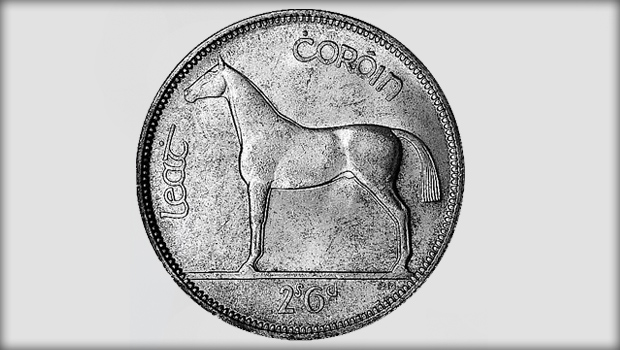by Peter Makem
Back in 1922, a commission was set up by the first Irish Government into creating a new coinage in an early attempt to remove British symbols. Among those people chosen to study the issue and come up with a new design were WB Yeats, and his domineering personality was soon in evidence when he proposed that the new coins use the image of animals, fish and birds pertaining to Ireland and Irish lore. For example, the salmon appeared on the florin, the hen on the penny, the hound on the shilling, the hare on the sixpence and pride of place went to the largest of the coins, the half crown with the superb figure of a horse.
We in Ireland prided ourselves in this animal above all. The limestone plains of the Curragh and Tipperary enrich the grass that enriches the pedigree and so we became world famous in breeding and training. We literally loved this animal without reserve. Until last month, when it appeared in our burgers.
In a recent issue of the Irish Edition, I mention the discovery in Ireland that some tests identified horse meat in hamburgers. But at the time, this was presented as an accidental thing, that somewhere along the line there was a mistake and ordinary cattle meat got somehow mixed up, and it would all be speedily rectified.
But it soon became apparent that this was no one-off accident, and that there was a deliberate and substantial campaign to include horsemeat in products advertised as “100 percent finest meat.” Things quickly developed. Some burgers were discovered to contain over 80 percent horse and the center of gravity moved from Ireland to Eastern Europe where the trade had been in full swing for a long time. Then, overnight, most of Europe was involved while supermarket chains loudly announced the removal of any such contaminated product from their shelves.
Many believe that these same stores knew all along or chose not to look closely at their meat and meat-related products. Many also believe that governments “had more important things to do than examine hamburgers.” But there is serious fear everywhere. While horse meat is a delicacy in some countries, the main pronounced danger is that aspects of the business is controlled by criminal gangs throughout Europe who will put elephant meat, snake meat, dog meat, gull meat, crow meat into the chain without the slightest qualm of palate.
The Irish meat industry is huge. There is consternation that the latest crisis will affect one of the economic mainstays, especially in these hungry times. It leads all the news items over here that what started as a trickle is now a flood.
I notice for the first time in many years that the small butcher’s shops are doing well. More and more shoppers are going to these stores where the meat is formally certified in the local abattoirs. As I see it, the boundless race for profits at all costs eventually charged into the middle of the meat industry and Murphy’s Law applied — “If it can happen, it will happen.” A specific variation of this law might apply to the present scandal, “If there’s a dollar to be made, a dollar will be made.”
I don’t know how this will all end up. I don’t eat many hamburgers, but I suppose like everybody else I’ve had a few bites of horse in recent times. I don’t want to think any further than that, because for all I know, the horse involved might have been an old and diseased animal grazing its last days on the plains of Hungary.

